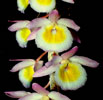|
|
|
|
|
| |
Flasks of
Dendrobium primulinum 'CedarWood Freedom' × self |
|
| |
|
|
| |
| Number: |
TN2921 |
| Name: |
Dendrobium primulinum 'CedarWood Freedom' × self
|
| Type: |
self (What's that?) |
|
Seed Donor: |
CJ Maciejeski
|
|
Click to Enlarge

Pod Parent Flowers |
|
|
|
| |
Culture Notes from Donor: Parent plant: Temperature range W (70-90°F)
Comments: A powerfully fragrant species with a scent reminiscent of that of unifoliate cattleyas, strong and floral that fills the greenhouse.
Parent plant: Medium-sized plant. Ten flowers on one pendulous pseudobulb; sepals and petals pale pink, flushed darker along margins; dorsal sepal slightly reflexed along basal edges, lightly recurved at apical tip; lateral petals forward-projecting, lightly reflexed along basal margins, slightly reflexed at tips; lateral sepals flat, held at obtuse angle relative to labellum, similar to petals, forming a mentum with columnar foot; labellum round, diaphanous, flushed pale pink along edges, disc bright golden yellow, throat striated deep magenta, deep magenta spot at attachment to columnar foot. Substance light, texture sparkling.
For additional origin/habitat information supplied courtesy of
Charles and Margaret Baker, see further below, near the bottom of this page.
|
Temperatures we attempt to use in the lab & greenhouse:
| For Species: |
|
Summer, Autumn: days average 81°F, nights 67°F; best fit is Intermediate 83-60°F
(Source:
Baker's Web OSC) |
| For Species: |
|
Spring: days average 87°F, nights 60°F; best fit is Intermediate 83-60°F
(Source:
Baker's Web OSC) |
| For Species: |
|
Winter: days average 79°F, nights 49°F; best fit is Cool 70-52°F
(Source:
Baker's Web OSC) |
|
About the name...
| Etymology of |
Dendrobium |
|
From Greek "dendron" tree and "bios" life.
(Source:
Pridgeon 1992) |
| Etymology of |
primulinum |
|
From Latin "primulinus" yellow like a primrose.
(Source:
Mayr & Schmucker 1998) |
| Pronunciation of |
Dendrobium |
|
den-DRO-bee-um
(Source:
Pridgeon 1992) |
| Pronunciation of |
primulinum |
|
prim-yoo-LEE-num
(Source:
Hawkes 1978) |
|
If you would like to direct someone to this web page, please copy and paste this URL into your email:
http://troymeyers.com/d?012921
| Flask Information |
| Availability: |
Capsule failed. We were not able to make any flasks. |
| You should: |
Consider placing a "Notify Retries" Request, and if an identical pollination (the same parents) is done again, we'll let you know. |
|
You might also want to:
|
View items of the same species.
View items of the same genus.
|
| Ordering Information |
| You are not currently logged in. |
|
You must be a registered user and be logged in to reserve a flask or place a notification request. Please log in:
|
|
|
|
|
|
| |
The origin/habitat information below is supplied courtesy of Charles and Margaret Baker
The following information is based on the name of the plant provided by the donor, and assumes that the name is correct. If the plant has been misidentified, then the following information may not be correct.
This text is copyrighted by the Bakers and may not be reproduced without permission.
ORIGIN/HABITAT: Widespread in India and Southeast Asia. Distribution
extends from near Mussorie in the Garhwal region of northern India,
through Nepal, Sikkim, and the Lushai Hills region of northeastern India,
the Chin Hills of Burma, the mountains of northern and western Thailand,
the Vientiane region of Laos, the Dalat, Blao, and Langbian regions in
Vietnam, and Yunnan Province in southwestern China. Plants usually grow on
deciduous trees at 1640-5250 ft. (500-1600 m).
More about this information and the Bakers...
|
|
|
| |
|
|
|